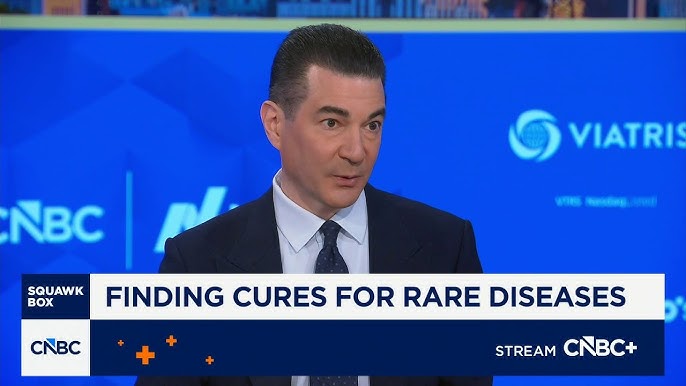
Dr. Scott Gottlieb on Finding Cures for Rare Diseases
Former FDA Commissioner Dr. Scott Gottlieb joins ‘Squawk Box’ to discuss the ongoing research and efforts at the FDA to find cures for rare diseases.…
Thought Leader: Scott Gottlieb

A star-studded mix of venture capitalists and scientists (including WWSG thought leader Dr. Scott Gottlieb), backed by more than a billion dollars, is launching an ambitious biotech that aims to reinvent drug R&D using artificial intelligence, the group exclusively told Endpoints News.
The company, Xaira Therapeutics, is one of this year’s most richly funded new companies, not only in biotech but across the startup world, reflecting the enthusiasm and technological progress in using AI to unlock the mysteries of biology. The group has tapped Marc Tessier-Lavigne, formerly the president of Stanford University and chief scientific officer of Genentech, as CEO to turn a cash-flush vision into reality.
“AI is going to transform every step of the drug discovery process,” Tessier-Lavigne said in an interview with Endpoints. “At the very least, everybody would agree it’s going to improve things incrementally: 10% here, 20% there, 30%. You multiply all of that out and you could get two-, three-fold improvements in speed and success rates.”
Drug R&D is an endeavor rife with failure — commonly cited figures estimate that only about 10% of drugs that make it to human testing are ever approved, and a far greater share fail before ever being tested in a person. Xaira and several other new biotechs believe they can change that with new generative AI methods that can design complex molecules from scratch, find new targets, and cut months or even years from the process.
Much of the new startup’s technology comes from the University of Washington’s Institute for Protein Design, the legendary protein science lab run by Xaira co-founder David Baker. Several scientists from Baker’s lab who helped develop models to design antibodies and other protein-based drugs have joined Xaira full-time.
The company, which has about 50 employees today at sites in Seattle and California, was co-founded by two of biotech’s biggest venture capitalists, Bob Nelsen of ARCH Venture Partners and Vik Bajaj at Foresite Labs, an incubator affiliated with Foresite Capital. Other investors include F-Prime Capital, NEA, Sequoia Capital, Lux Capital, Lightspeed Venture Partners, Menlo Ventures, Two Sigma Ventures, and SV Angel.
Using AI to make drugs isn’t a new idea. Investors have poured hundreds of millions of dollars into earlier startups with little to show for it so far. And many scientists remain deeply skeptical that so-called de novo antibody generation — using computers to design brand new proteins — is mature enough for making medicines. But Xaira’s leaders say they’re confident it’s ready for prime time.
“We believe the technology is ready for making therapeutics today,” Tessier-Lavigne said. “We think it’s going to get better and better.”
Along with the high-profile executive team, Xaira’s board is full of stars who have climbed to the highest ranks in the regulatory, scientific, and corporate worlds that shape the industry Xaira plans to reinvent. Board members include former FDA head Scott Gottlieb, Stanford chemist and Nobel laureate Carolyn Bertozzi, and former Johnson & Johnson CEO Alex Gorsky.

Xaira’s funding makes it an instant leader among the newest generation of leading AI biotechs, alongside Alphabet’s Isomorphic Labs and Flagship Pioneering’s Generate:Biomedicines.
All three are advancing their own AI models to either predict the complex three-dimensional structures of proteins or generate new proteins entirely, both of which are crucial starting points for designing new drugs. Isomorphic CEO Demis Hassabis has talked of “reimagining drug discovery from first principles using computational methods,” most recently partnering with pharma giants Eli Lilly and Novartis. Generate has raised nearly $750 million and built a pipeline of 17 protein-based drugs, with plans to add 10 more annually.
Xaira, which was incorporated last May and went by the name Orion Medicines while in stealth, is setting its initial sights further. The company wants to apply AI across three areas: discovering new biology, designing molecules, and running clinical trials.
“We’ve all been kind of waiting for the moment where we could rethink this fairly inefficient, some may even argue broken, industry that has low single-digit success rates and sometimes makes medicines that are curative, but a lot of times doesn’t,” ARCH’s Nelsen said in an interview with Endpoints.
“What we don’t want to do is change just one little vertical silo,” Nelsen said. “We can think — and have the resources to think — horizontally about the whole system.”
To better understand biology and hunt for new drug targets, Xaira has brought in teams and technologies from the genetic sequencing giant Illumina as well as the biotech startup Interline Therapeutics focused on the hot science of proteomics, how proteins change in health and disease.
“Proteins are the molecular machines that drive biology. They are the targets of the vast majority of drugs,” said Don Kirkpatrick, a former Interline leader and now a vice president at Xaira. “And they will end up being the biomarkers that in many cases we will pursue to understand when a molecule is working or not.”
Kirkpatrick’s group is focused on running perturbation experiments — disturbing genes, proteins, or pathways in cells — at massive scale to start establishing causal links between a drug target and a biological outcome. The goal is to build a foundational AI model from these data that understands what goes wrong in a disease, and how to fix it.
To make actual drug candidates, Xaira will advance AI models developed in Baker’s lab called RFdiffusion and its specialized successor RFantibody — revealed in an academic preprint last month.
These computer programs are similar to the diffusion models that power image generators like OpenAI’s DALL-E. But instead of concocting art or a photo based on a text prompt, Baker’s models can create molecular structures of built-to-purpose proteins, such as antibodies that neutralize a virus or kill cancer cells.
Historically, there’s been a fair amount of luck involved in discovering antibodies, which are often sourced from the blood of mice or people. Using AI to design the drugs could allow researchers to hone in on known weak points of a virus, cancer cell or problematic protein that the immune system isn’t good at finding on its own.
“This idea of building antibodies from scratch and getting hits out of nowhere, there really hadn’t been a way to do that before,” Baker said.
However, other experts have said that the antibodies in Baker’s preprint were too weak to become good drugs and noted that the targets in the paper were easier ones, including well-studied coronavirus and influenza proteins.
Tessier-Lavigne was insistent that RFantibody would get better with time, and that Xaira could use traditional antibody engineering approaches to refine what the computer creates. One of AI’s biggest benefits, he said, may be in generating leads on antibody drugs that are difficult or impossible to make through the traditional luck-of-the-draw approaches.
And while many drugs fail because the molecules are too weak or too toxic, others fail because researchers chose the wrong group of patients, or failed to select the best clinical signals to tell if a treatment works or not.
Foresite’s Bajaj said Xaira’s clinical goal is to do for other drugs what genetics did for oncology — moving the field from broad, toxic chemotherapies to targeted precision medicines.
In cancer, that strategy succeeded because many tumors are driven by one or two genetic mutations. Common diseases, though, pose a far more daunting challenge, driven by a dizzying mix of environmental and genetic contributors.
“We now have enough data that we can actually approach problems like that and predict, in an oncology-like way, how people will respond to drugs that treat really common disease,” he said.
And although Xaira is initially focused on antibody drugs, its leaders see no reason that its AI tools can’t be applied to other therapeutic modalities in the future, like small molecules (though the company declined to share its early targets or timelines).
The CEO role is a new position for Tessier-Lavigne, who resigned as Stanford’s president last year amid a controversy over several old research papers from his laboratory containing manipulated data. Several papers with his name on them were corrected or retracted. An internal investigation found no evidence that Tessier-Lavigne personally manipulated data or committed fraud, but did outline weaknesses in how he managed his laboratory.
When asked what he learned, Tessier-Lavigne said that it’s important to not take data at face value. “That’s certainly a lesson I’ve taken to heart and am carrying forward,” he said, but he didn’t name any specific controls he would put in place at Xaira.
In the AI field, where hype and skepticism both find their zeniths, scrutiny is sure to be high. Companies have made big promises about using AI to revolutionize drug discovery before – albeit never with this much money.
“We all became convinced that there was an enormous opportunity here to construct the next Regeneron or Genentech, something with the foundational technologies today,” Bajaj said. “They are no less important than the foundational technologies that launched those companies.”
Dr. Scott Gottlieb on Finding Cures for Rare Diseases
Former FDA Commissioner Dr. Scott Gottlieb joins ‘Squawk Box’ to discuss the ongoing research and efforts at the FDA to find cures for rare diseases.…
Thought Leader: Scott Gottlieb
Peter Zeihan: U.S. Navy Seizes Russian Tanker
The US Navy just seized a shadow fleet tanker that managed to slip past the naval quarantine around Venezuela. The tanker reflagged as Russian while…
Thought Leader: Peter Zeihan
Erika Ayers Badan: Surviving Company Failure
In this episode of WORK: Unsolicited Advice, Erika talks through what it really looks like to come out of the worst month of your career…
Thought Leader: Erika Ayers Badan

